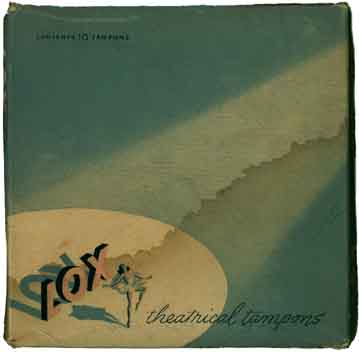Ads for teens (see also introductory page
for teenage advertising): Are you in the know? (Kotex napkins and Quest
napkin powder, 1948, U.S.A.), Are you in the know? (Kotex napkins, 1953,
U.S.A.), Are
you in the know?
(Kotex napkins and belts, 1964, U.S.A.), Freedom (1990, Germany), Kotex (1992, U.S.A.), Pursettes (1974, U.S.A.), Pursettes (1974, U.S.A.), Saba (1975, Denmark)
More ads for teens:
See a Modess True
or False? ad in The American Girl
magazine, January 1947, and actress Carol Lynley in
"How Shall I Tell My Daughter" booklet ad
(1955) - Modess . . .
. because ads (many dates).


|

LOX theatrical menstrual tampons
(1930s-1940s?, U.S.A.)
The manufacturer wanted LOX - no
connection to bagels! - to suggest
"locks," meaning that it wouldn't
fall out during stage performances
- or at least Lox would lock in
the menstrual discharge. A menstruating
woman who had to perform in
front of an audience had big
problems until recently (and sometimes
still today). Two German
writers pointed out that women in
the theater profession, in
Germany, anyway, were among the
few women who used special
menstrual protection, like pads,
in the 19th and earlier centuries.
Otherwise, most women bled into
their chemise or other clothing,
sometimes for days without
changing. (Read a discussion
of this.)
It seems amazing that a company
would develop a tampon
specifically for stage use (but
that apparently was an early use
for tampons; see the instructions
for Tamponettes),
but
possibly it cost more. Someone - a
clerk? - wrote ".50" on the box,
maybe meaning 50 cents, which
would be five cents a tampon, I
believe expensive in the late 30s
or early 40s, when I think this
appeared. Tamponettes cost 2.4
cents apiece in 1939.
Procter & Gamble kindly
donated the box of tampons in
2001, part of a huge gift of
ancient menstrual products.
|
|

|
|

Each of the ten
tampons come wrapped in
cellophane.
|
|

|
The cardboard
applicator is 5.25" (ca.
13.3 cm.) long, the
tampon 2" (ca. 5.2 cm.)
long. There is only one
tube, as opposed to the
triumphant two-tube
Tampax, which appeared
in the early 1930s
(Tampax patent).
See
the instructions
for how LOX works, its
theory, and the sales
pitch.
|
|
� 2001 Harry Finley. It is illegal to
reproduce or
distribute any of the work on this Web site
in any manner
or medium without written permission of the
author.
Please report suspected violations to [email protected]
|